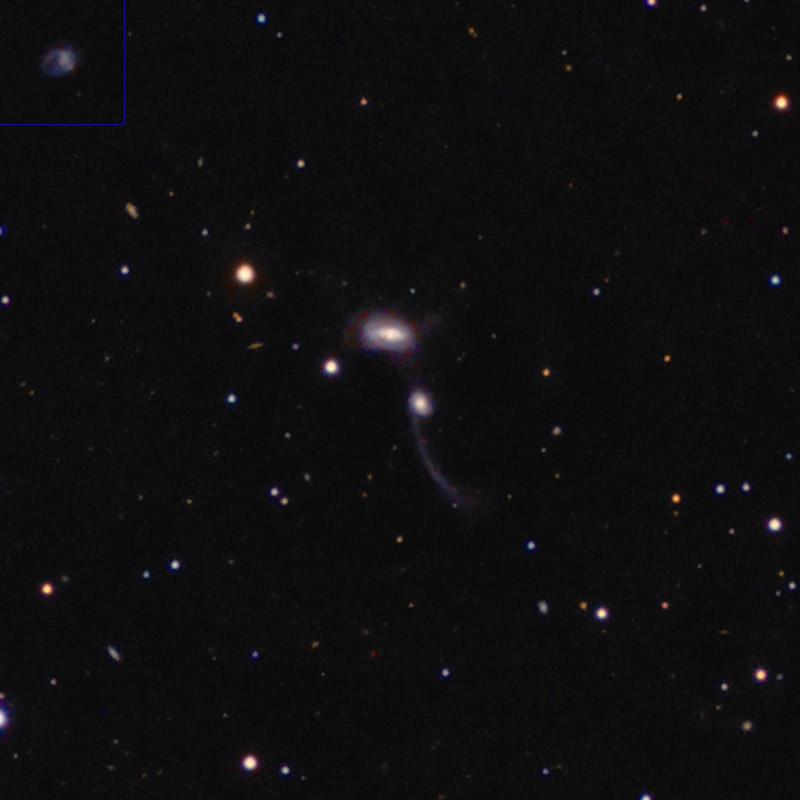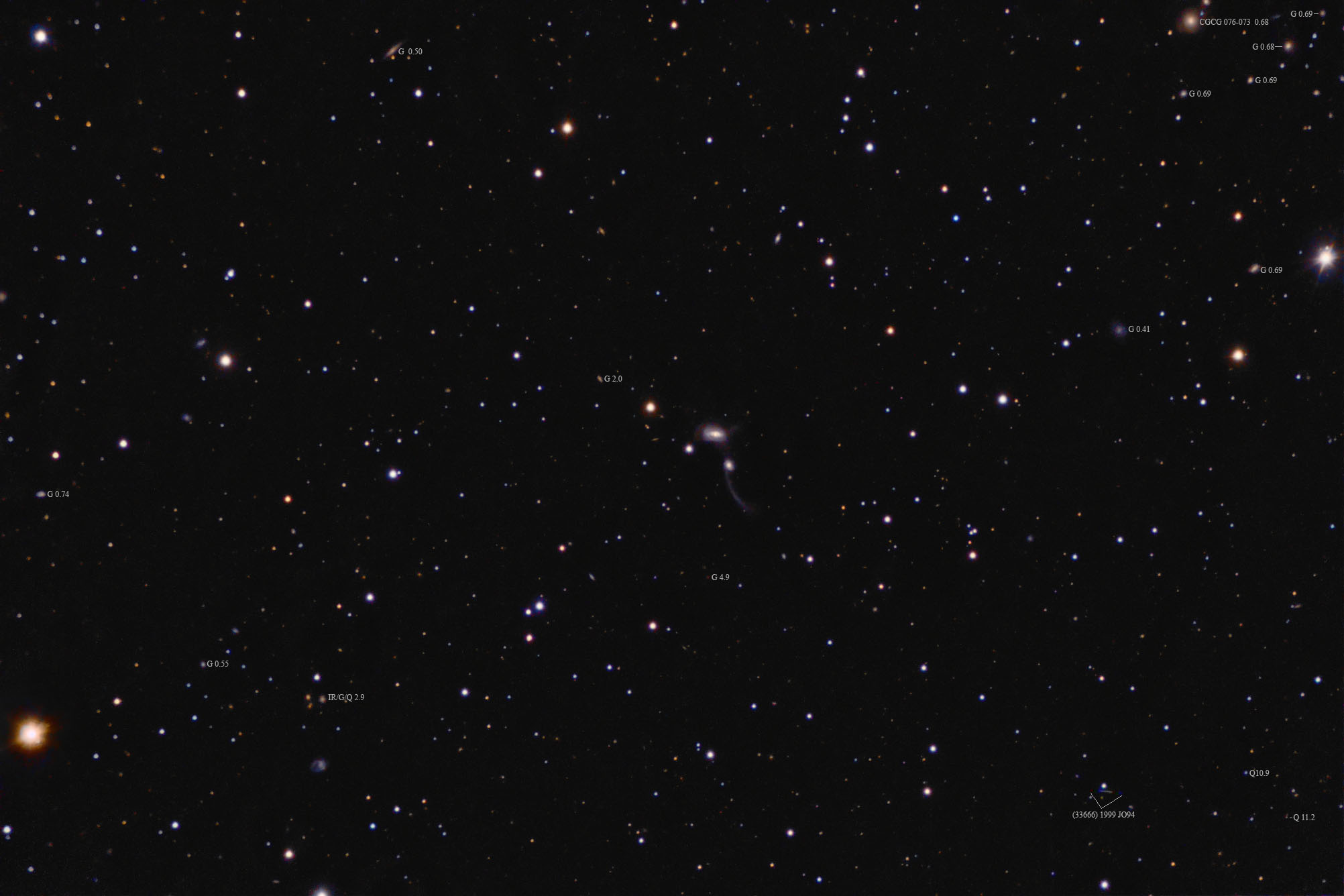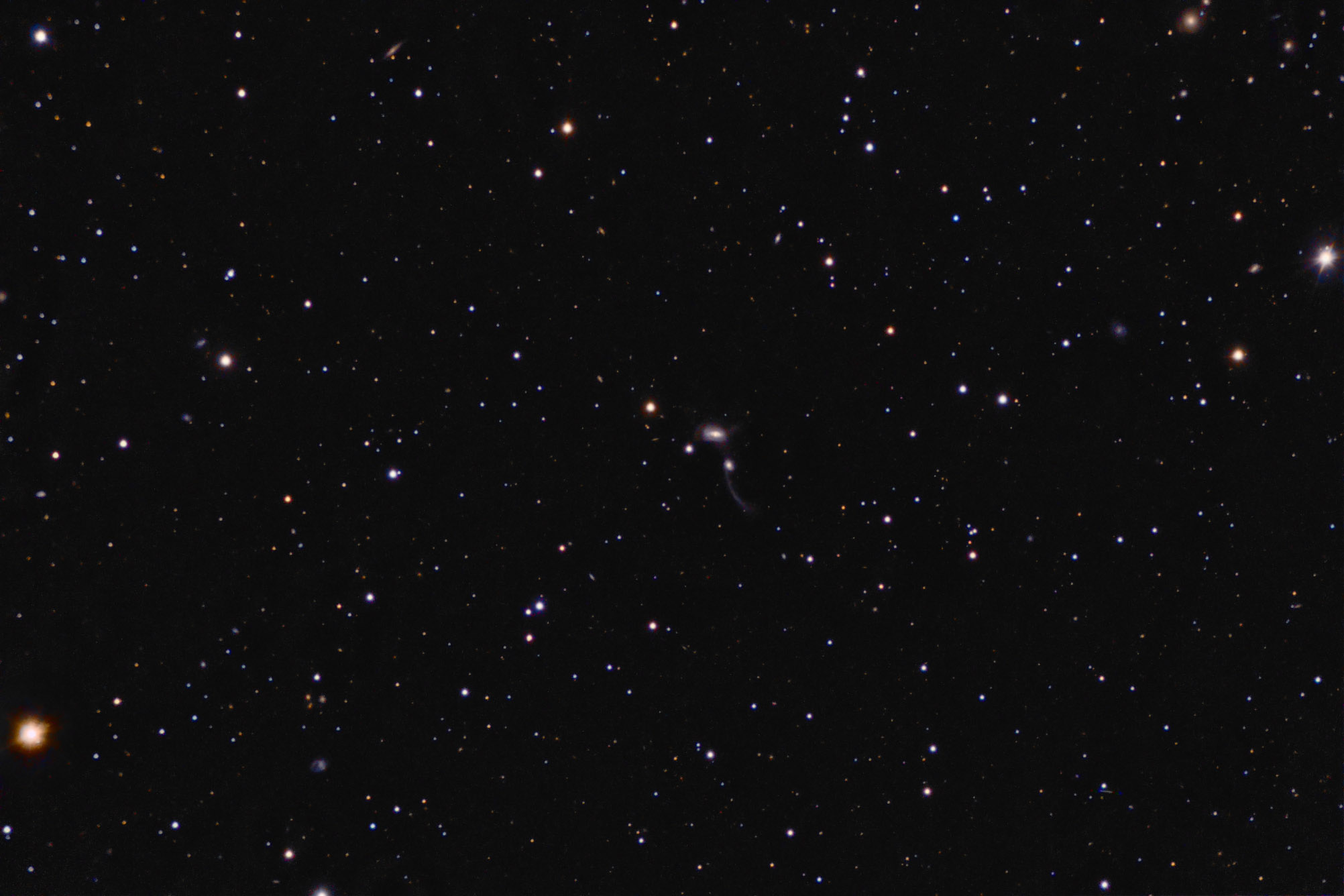Object name: ARP173 Arp 173/UGC 9561 is a pair of galaxies about 410 million light-years away in the southeastern corner of Bootes. The northern galaxy is MCG +02-38-20/PGC 53053 while the southern is MCG +02-38-19/PGC 53054. The northern one is classed S0 by NED which I find puzzling as it seems to have too much structure for that classification. The southern one is classed simply as S? Except for the plume, it seems to fit the S0 class. Makes me wonder if NED reversed these classifications. The PGC designations also appear reversed as normally they are in RA order but that is not the case with these two. In any case, Arp put this in his class for galaxies with narrow counter tails. There is certainly a nice narrow plume heading south and a bit west from the southern galaxy. There appears to be a broad plume toward the northern galaxy as well. Several plumes extend in various directions from the northern galaxy. Obviously, these had a close passage by each other in the recent past. One paper indicates the authors think the northern galaxy should be designated as a Seyfert 2 galaxy. NED apparently disagrees as they don't indicate this in their classification.
Well to the southeast of Arp 173 is the strange distorted galaxy MAPS-NGP O_502_0362090. This is the only designation given for it at NED. This surprised me as it is well imaged in the Sloan survey yet NED doesn't pick it up in that survey. Quite common I've found, especially with blue galaxies of low surface brightness such as this one. There's no redshift data on it so I can't tell if it is related to Arp 173 or not. I'm surprised Arp ignored it. It certainly is peculiar looking.
Just north of this galaxy is an object listed as an IR source in the 2MASS catalog and a galaxy and quasar in the Sloan Survey. I've noted it as IR/G/Q in the annotated image. Its redshift puts it about 2.9 billion light-years away so it is pretty big and bright for a galaxy. I see no hint of a brilliant quasar at its heart, however.
West and a bit north of Arp 173 is a very blue disk galaxy also at about 410 million light-years. It too has very low surface brightness. It was picked up by the Sloan survey and is in other catalogs including LEDA as LEDA 4550853. It appears rather normal however so doubt it has interacted with Arp 173.
In the southwest corner is asteroid (33666) 1999 JO94 shining at an estimated magnitude 18.6. You'll note there are red green and blue frames on either side of the luminosity frame. Due to weather and meridian issues, I took the first red, green, blue series then the 4 luminance frames. I was sure clouds were going to cut off my imaging. By then I had to move to the other side of the meridian. I did so and took the remaining three color images while the clouds never came rolling in, whew.
In the annotated image there's a very red but faint (magnitude 21.2) galaxy with a redshift of z=.484314 which puts it about 4.9 billion light-years away light travel time. It is directly south of Arp 173. In the lower right corner beyond the asteroid is a very blue star that is a quasar with a redshift of z=2.357128 which puts it at 10.9 billion light-years light travel time. Just beyond it is an even more distant quasar. It has a redshift of z=2.611678 and a light travel distance of 11.2 billion light-years. While the light took 11.2 billion years to reach us it wasn't that far away when the light left the quasar over 11.2 billion years ago. The universe has been expanding. The quasar was less than 6 billion light-years distant when the light left it. "Today" if the quasar even exists this expansion has moved it to where it is nearly 20 billion light-years from us. This leads to some amazing conclusions. 11.2 billion years ago the universe was only 2.7 billion years old and thus any astronomer of that time could see only 2.7 billion light-years away. Actually less but I won't go into that issue. Yet this quasar was 6 billion light-years away. It was beyond the observable universe to such an early astronomer. Given enough time though, as the universe aged such an early, and very long-lived, astronomer, could eventually see the quasar, it was now within the observable universe. But "now" it is nearly 20 billion light-years distant and the universe is only 13.7 billion years old. Given enough time would we see the light it is emitting today? No, we will never see that light. For it to have moved from about 6 billion to 20 billion light-years away (actually we are both moving apart) it has moved about 14 billion light-years in 11.2 billion years. That means we are now moving apart faster than the speed of light! Thus, the light it emits "today" is actually getting further from us each day even though it is moving at the speed of light. The race is lost even before it has begun. Now, this does not violate Einstein's relativity. That says nothing can accelerate through space faster than the speed of light in a vacuum, it puts no restrictions on how fast space itself can expand. Space is free to expand at any rate even one far exceeding the speed of light.
In the upper right corner are several galaxies at about 680 to 690 million light-years. This group has more than a dozen members, most of which are off the image to the northwest. I found no recognized cluster in the area, however.
Arp's image
http://ned.ipac.caltech.edu/level5/Arp/Figures/big_arp173.jpeg
14" LX200R @ f/10, L=4x10' RGB=2x10'x3, STL-11000XM, Paramount ME | | 

